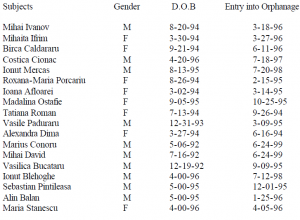Kendra Driggs and Professor Daniel Ferguson, Recreational Management and Youth Leadership
Attachment is an enduring connection established between a child and caregiver in the first several years of life. During this sensitive period, attachment influences every component of the human condition, including, mind, body, emotions, relationship, and values. It has been observed that attachment is a physiological, emotional, cognitive and social phenomenon. Attachment is something that a child and caregiver create together. Attachment disorder results when children fail to develop normal, healthy, and secure attachments to loving, protective caregivers.
Attachment disorder can be diagnosed based on traits and symptoms displayed through behavior, emotions, thoughts, relationships, physical appearance, and moral and spiritual views. Through observation of the orphans and interviews with the primary caregivers at the orphanage, primary symptoms of attachment disorder were observed in each of the subjects.
Behaviors and emotions of the children were observed on a daily basis during July and August. The most prevalent symptoms of attachment disorder were those involving behavior, emotions, and physical appearance. Each of the subjects displayed oppositional and defiant behaviors, as well as aggressive and abusive behaviors. Hyperactivity is a primary symptom seen among the majority of institutionalized children.
Emotions displayed were those of intense anger, irritability, and temper. Sadness, depression, and moodiness were also observed on a daily basis. Many times children showed no emotion despite specific situations of arousal.
Physical appearance can be used to diagnose attachment disorder. Symptoms such as poor hygiene, accident prone, high pain tolerances were all observed amongst the subjects in the study.
Other symptoms such as thoughts and relationships were accounted for through interviews with the subjects’ caregivers. The lower functioning children in the study have difficulty in making associations of cause-and–effect thinking, as well as, attention and learning problems. Regarding relationships, caregiver’s observations and daily living with the subjects show that the subjects lack trust, are manipulative, fail to give or receive genuine affection, and are indiscriminately affectionate with strangers.
The signs of attachment disorder are in congruency with the amount of time that the subjects have been in the orphanage. Those subjects who have been in the institution longer seem to have the most severe case of attachment disorder. Caregivers and observation suggest that the child will continually to develop problems concerning attachment unless removed from the institution.
Caregivers state that there is no difference among the children’s behaviors after B.Y.U students continually leave, offering no real relationship of security and longevity. The caregivers suggest that the children are quite resilient to the stresses of institutional living. On average, one to two caregivers are expected to divide their time among approximately 15 children on a daily basis. Therefore, the time divided among the children is unequal and inadequate if children are to develop normally.
The most obvious recommendation for the reversal of attachment disorder is to place all the children in a normal and healthy environment where they would be able to receive the attention needed in order to properly develop. The workers in the orphanage need to realize their primary role as caregivers and need to develop a relationship of love and trust. More caregivers need to be hired so as to allow more one-on-one attention between the child and primary caregiver. Open institutions (where children are able to leave the institution throughout the year) and foster homes need to be implemented more throughout the country to allow the greater possibility for children to receive a home environment. Educational activities need to be continually used so as to stimulate the child physically, emotionally, and mentally so they will not become as vulnerable and susceptible to the symptoms of attachment disorder.

